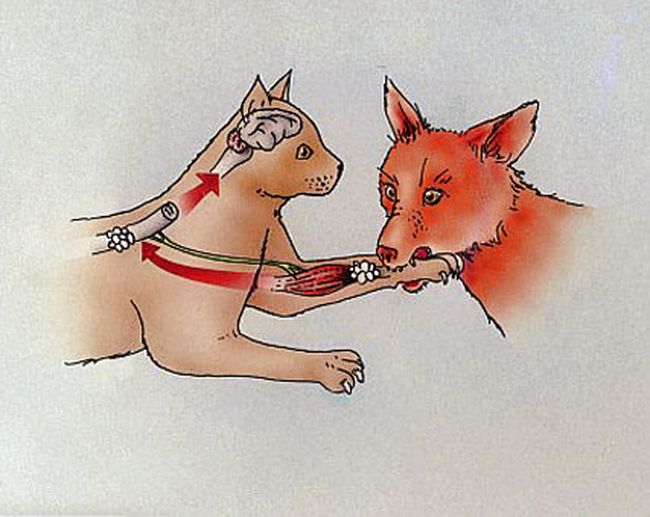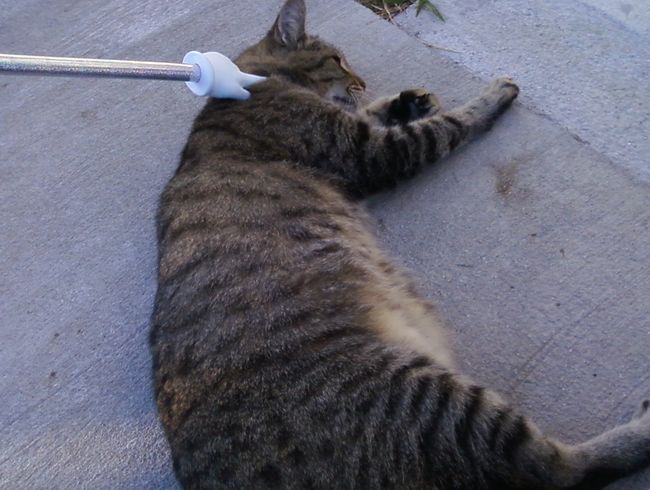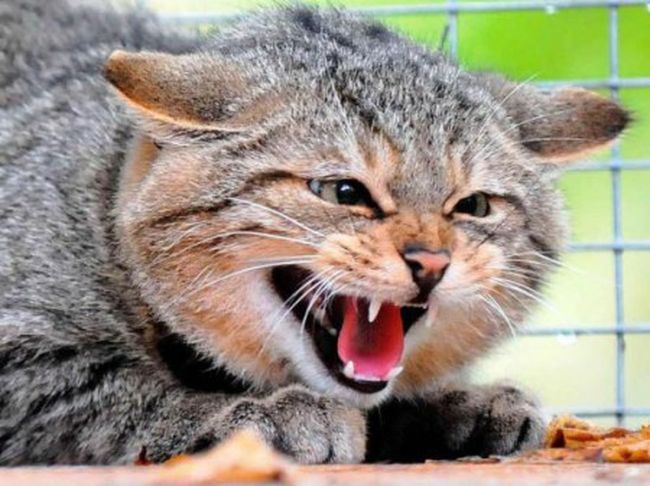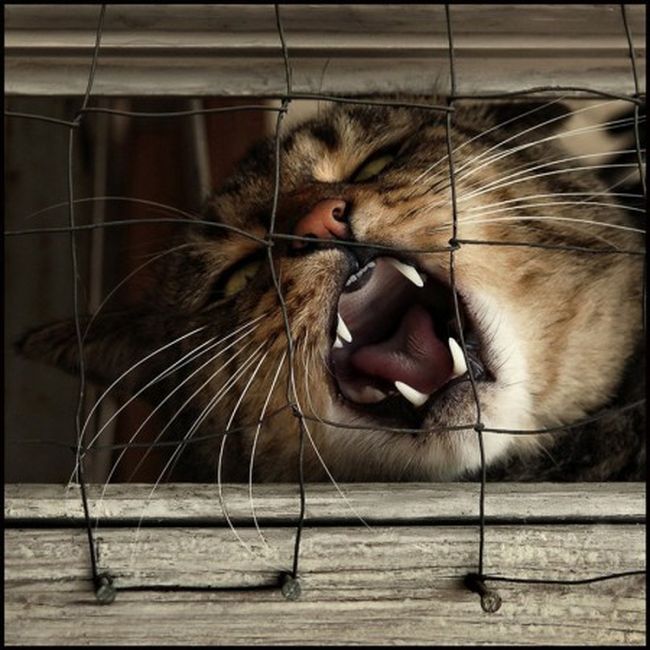Rabies in cats - a dangerous disease of viral nature, which is accompanied by irreversible lesions of the nervous system and always ends in death of the animal. Infected with rabies is easy enough, so the disease may be dangerous to humans. To prevent illness, enough to know, How does rabies in cats, and what can be done, to save a pet and to avoid infection.
Ways of infection with rabies
any mammal (in particular - Predators) sick with rabies, because you can catch a disease by direct contact with infected animals. Infected animals may bite a cat or vice versa - the cat eats it, after which the virus enters the body.

From an animal infected with rabies without vinegar can also - via damaged skin (fresh scratches, irritated skin, abrasions) saliva of an infected animal enters the body. I.e, at the time of infection of the skin barrier properties must be significantly disrupted.
note! Most often carriers of infection in urban areas are rodents, from which cats and infected with rabies.
In cats in rural areas likely to be infected with rabies more, because wild animals are often penetrate into the yards of private homes, among which are carriers of the disease are raccoons, foxes, badgers etc.
Also recorded cases of rabies through food and the air, although they are rare. Most often, susceptibility to infection depends on the animal and the strain of the virus: in older cats with reduced immunity likelihood of contracting the disease is higher, and virus propagation process is much faster.
Important! The bite of a rabid animal does not always speak about infection. only in 15-20% cases of human infection occurs or a cat with rabies.
The incubation period in a cat with rabies may vary, and it depends on the amount of virus, the injury and its value. The farther away from the brain was produced by the bite, the longer the incubation period. for example, if infected animal hindpaw, the path of the virus along the nerve fibers to the brain significantly longer, than the bite in the neck.
Usually the first symptoms of rabies in cats begin to appear later 10-18 days after contact with an infected animal, but there were also cases of, when the symptoms began to manifest itself after a few months or even a year after infection. But count on luck in these situations is not necessary - the rabies virus begins to stand out in the cat saliva even before the onset of clinical symptoms.
Forms and manifestations of rabies in cats
After infection, the disease usually develops in stages (prodromal, manic and depressive stage), but there are cases, when some of the steps may be skipped. In cats, the virus after being bitten by spreading along nerve trunks in the direction of the brain, then gets into the salivary glands of an animal.
The process of propagation and multiplication of the virus occurs quite difficult and has not yet been able to find out, what happens to the brain neurons exposed to the virus. There is only the sad result - inevitably infected animal dies.
Rabies in cats can be a long time does not show itself, or symptoms of the disease may resemble other diseases. How to identify rabies in cats, if the pet does not give cause for trouble? Manifestations of rabies depends on the form of the disease and the strength of the virus effects on the nervous system of cats.
Important! It is a mistake to believe, that the signs of rabies in cats - it's sure to aggressive behavior of animals and incoordination. Manifestations of the disease can be, as a high, and low activity of cats, playful or too nervous behavior. Any atypical behavior of a pet can be a cause for concern.
Forms rabies in cats are divided into three types:
- Atipichnaya;
- easy;
- acute.
Atipichnaya form
It is quite rare and it is very difficult to recognize. Because of unexpressed clinical form is considered the most dangerous: neurological symptoms are not usually seen, but you will notice dyspepsia:
- Diarrhea;
- general lethargy, drowsiness;
- vomiting;
- depression;
- Lack of appetite;
- Constipation;
- Feces and vomit mixed with blood.

Finally, disease ends strongest exhaustion, after which death occurs.
The incubation period for this form of the disease and the "blurring" of symptoms does not allow time to diagnose rabies, therefore there is a high risk of human infection.
mild form
This form of the disease also is characterized by a pronounced neurological symptoms, but the presence of disorders of the nervous system of the cat is still possible to make out. It appears more, the cat becomes overly intrusive and tender, It requires attention, He is trying to get on your hands, to be closer to the owner.
Of course, for most cats this behavior is quite typical and it is not surprising. But if the cat had not showed too much love for man, and by the people, such behavior should alert the owner.
In this form of rabies is gradually developing paralysis of the throat, accompanied by the following symptoms:
- persistent cough;
- excessive salivation;
- the emergence of feelings, the cat is always something chokes.
Latent virus occurs (ie. in a hidden form), but it is already present in the saliva of cats. There exists the danger of contracting a disease when viewed from the oral cavity of the animal.
Hazardous (largest) the form
This is the classic and most common form of rabies in cats. The initial symptoms of the disease usually do not give cause for concern, but soon cat varies unrecognizable.

Lush form occurs in three phases, each of which is characterized by its own manifestations.
How to identify rabies in cats with violent form:
- prodromal phase. There is increased nervousness animal, Frequent symptoms of anxiety, sometimes possible to increase the temperature. cat's mood often changes from playful to hostile (or vice versa), aggressive cats can become obedient, friendly - irritable and fearful. A characteristic feature of this phase: the animal is constantly licking the bite and exhibits enhanced rabies. Prodromanalny period lasts on average 1-2 day and proceeds either in phase or directly in the excitation paralytic.
- excitation phase (maniakalynaya). Signs of rabies amplified: salivation because of what the wool around the jaws and neck are constantly wet, lower jaw droops, there is irritability to light and sound, loss of appetite, there is a violation of orientation in space, possible convulsions. The cat's behavior becomes inadequate: sick cat can attack man, can cling to the face or bite. Stage lasts about 2-5 days, after which the disease goes into the third stage of an animal immediately killed.
- paralytic (depressive) phase. The cat develops paralysis of limbs, there comes a sharp deterioration and subsequent death within a 2-4 days. symptoms: excessive salivation, wheezing during breathing, gradual paralysis, cat does not respond to others, comes airway spasm.
Disease in cats is developing rapidly - usually within 7-10 days the animal dies. Kittens rabies symptoms are no different from adult cats, but dangerous virus is faster acting and the disease lasts only a few days.
Symptoms of rabies in humans
During the incubation period for rabies, flowing in cats, People can become infected by a pet in two ways: First - it is through the cat's bite, second - through the saliva of the animal in the presence of injured skin (scratch, wounds, skin irritations).
Signs of rabies in humans after a cat bite:
- Excessive irritability and activity;
- Photophobia and photosensitivity;
- Aggressive behavior;
- Disturbances in speech and coordination of movements;
- The feeling of fear and panic;
- The emergence of hallucinations;
- Cramps and muscle spasms;
- paralysis of limbs;
- excessive salivation.

Manifestations of rabies and the incubation period of the disease in humans is dependent on the state of health, age of the patient and the presence of other diseases. You can get sick within a few days after being infected by a virus or a cat a cat. After detection of one or bite (or more) rabies symptoms the person should see a doctor. The doctor will make an analysis of rabies, introduce serum and prescribe antiviral drugs to combat the disease.
Diagnosis and treatment of rabies
Diagnose rabies in cats, Unfortunately, only posthumously. Upon detection of the symptoms of the animal are isolated, and when it dies, brain research conducted for the presence of virus.
Some modern research methods allow to diagnose disease using saliva tests and cerebrospinal fluid of the animal. But in the wider circles of laboratories and veterinary hospitals such methods are not applicable.
Important! Treatment for rabies is not carried out - the cat die anyway, and attempts to treat a sick animal can lead to contamination of personnel.
What to do if rabies in cats:
- to isolate the animal;
- Report of a case of the disease in the veterinary clinic;
- Do not attempt to calm the cat with the apparent manifestations of aggression.
The most humane solution for the detection of rabies in cats is euthanasia - sick cat euthanized. This measure will prevent the further spread of infection and prevent animal flour.
Person, is bitten by an infected cat, must clean the wound under hot running water and plenty of soap (it's desirable, economic, tk. it contains more alkali). Thereafter, during 72 hours should contact the hospital for rabies treatment, which includes a series of injections over six months.
Vaccination and prevention of rabies in cats
The only reliable method of preventing rabies - vaccination. After being vaccinated against rabies animals have a very low probability to be ill with rabies. Vaccinations are mandatory for all animals, regardless of their content.
note! Owners of pets are often asked: how much is a vaccination against rabies cat? Need to know, that in Russia such a vaccine is free in all municipal veterinaries.
First time to be vaccinated against rabies at four months of age should be, and after repeated vaccination, When the cat is one year old. Subsequent rabies vaccination for cats do animals annually until the end of life.
Bitten by an infected animal cat, even when the vaccine available in the body is subjected to re-vaccination, and then it remains in the veterinary clinic on quarantine. That is, the infection can be transmitted even before the cats vaccinated against rabies.





